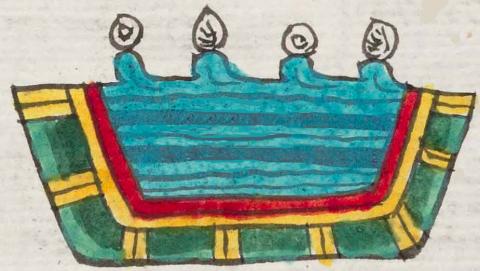atl (Mdz18r)
This element for atl, carved from the compound glyph for the place name Atlan, strongly resembles a water channel or canal (apantli). We have removed the teeth from the middle of the water so as to isolate the atl) from the compound. If it is reliable to say that this is an apantli being used for atl), what we are seeing appears as a cross section, where we can see the bottom and sides of the canal and the water (atl) inside it. The result is that it appears to be a topless vessel for water. The exterior is green with eight double-yellow stripes cutting across it. Then there is a solid yellow lining just inside the exterior, and within that a solid red lining. The water is turquoise with somewhat wavy, alternating thin and thick black lines, seemingly indicating currents or undulations. Splashing off the top of the water are alternating white turbinate shells and circular, white, water droplets/beads. Turbinate shells are more clearly illustrated in the line drawings provided here
Stephanie Wood
The particular place name from which we have derived this representation of the atl), Atlan, does not include the -pan- element of apantli. Nevertheless, in many other glyphs, this particular sign represents "apan." See, for example, how apantli appears in the Acuitlapan compound glyph, below. The usual sign for apantli consists of two elements, atl (water) and pantli (agricultural furrow). Thus, it also works as an agricultural ditch meant for irrigation. But the detail of the cross-section of the bottom and sides of the canal suggest some degree of human intervention or construction. The red and yellow strips surrounding the water are somewhat reminiscent of the lines at the bottom of the tepetl sign, perhaps indicating where the mountain spring water might emerge. Just as the Atlan glyph uses the apantli in place of atl, we have several examples of what might appear to be a simple atl) glyph where the glosses support the phonetic reading of apantli, as shown in additional attestations on the lower right of this record.
A great many of the apantli glyphs from the Codex Mendoza are simpler than this one. The edging of the water channel calls for greater iconographic analysis. Similar patterns appear in reference to bodies of water in the Codex Nuttall, cited by Barbara Mundy as appearing on pp. 51 and 75. [See her contribution "Mesoamerican Cartography," in The History of Cartography, v. 2, bk. 3 Cartography in the Traditional African, American, Arctic, Australian, and Pacific Societies (Chicago : University of Chicago Press, 1998).]
John Montgomery reproduces this glyph and another one, for comparison, calling them bodies of water. The second one comes from the Viena Mixtec manuscript, 47b. Both have a containing structure, small waves, shell associations, and perhaps droplets.
Stephanie Wood
c. 1541, but by 1553 at the latest
Stephanie Wood
water, shells

apan(tli), water channel or canal, https://nahuatl.wired-humanities.org/content/apantli
pan(tli), furrow, https://nahuatl.wired-humanities.org/content/pantli
-apan (locative suffix), on the water, https://nahuatl.wired-humanities.org/content/apan-0
a(tl), water, https://nahuatl.wired-humanities.org/content/atl
-pan (locative suffix), on, https://nahuatl.wired-humanities.org/content/pan
water channel or canal
acequia de agua
Stephanie Wood
Codex Mendoza, folio 18 recto, https://digital.bodleian.ox.ac.uk/objects/2fea788e-2aa2-4f08-b6d9-648c00..., image 46 of 188.
The Bodleian Libraries, University of Oxford, hold the original manuscript, the MS. Arch. Selden. A. 1. This image is published here under the UK Creative Commons, “Attribution-NonCommercial-ShareAlike 3.0 License” (CC-BY-NC-SA 3.0).





